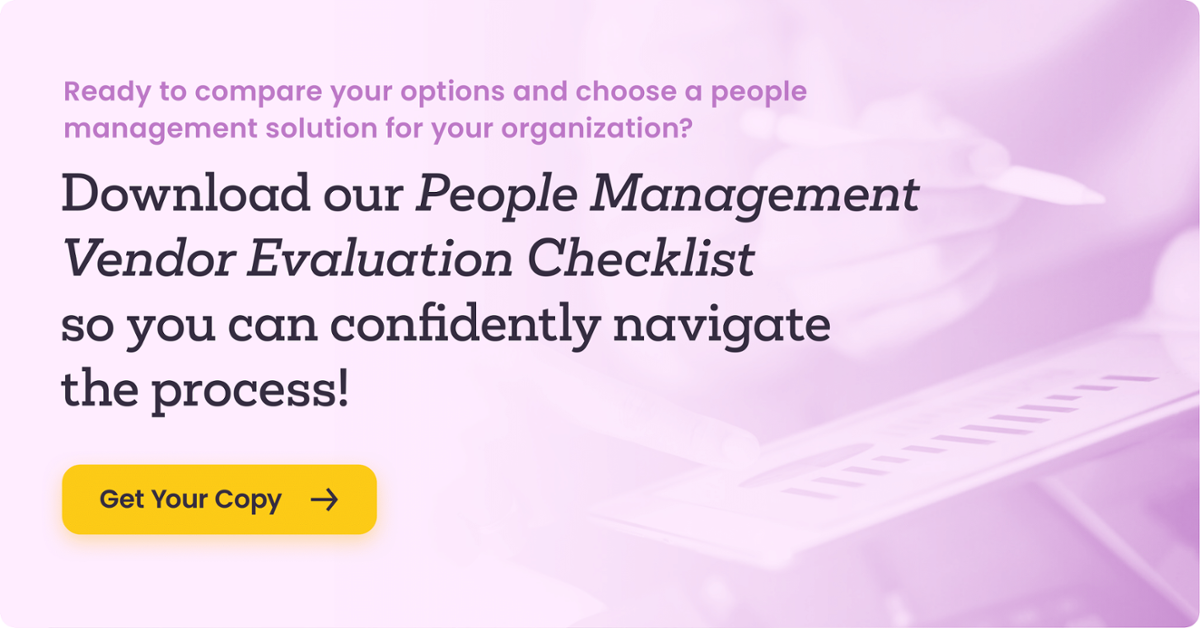Top 7 HR Metrics to Measure that Prove Succession Planning Is Working
 Succession planning is key to promoting a successful future for your top performers and your company as a whole. Many companies are able to greatly improve their approach to strategic succession planning by investing in a software solution designed for this people management process.
Succession planning is key to promoting a successful future for your top performers and your company as a whole. Many companies are able to greatly improve their approach to strategic succession planning by investing in a software solution designed for this people management process.
If you’re considering this investment for your organization, you want to know (and be able to convince all stakeholders) that you can expect a positive ROI. If you’re already implementing succession planning, then you want to know the investment you made is paying dividends.
Fortunately, you can make an informed prediction of the positive impact succession planning will have on your organization, and you can measure the success of succession planning by tracking the right HR metrics.
Making a Business Case for Succession Planning
The best way to prove the efficacy of succession planning is to compare your own historical data to new data to demonstrate improvement. However, you can still make a solid case for succession planning to leadership even without this data.
Succession planning can help you improve your business and boost profitability in a few key ways:
1. Improve employee retention and engagement.
Are your employees disengaged or leaving your company to pursue other opportunities? Succession planning demonstrates to your employees that you care about their career advancement and their future at your company, which can promote higher motivation, engagement, and job satisfaction.
Offering training opportunities or involving employees in developmental reviews, for example, can complement your succession planning efforts and help employees achieve their personal and professional goals. A LinkedIn survey found that an astounding 94 percent of employees say they would remain with a company longer if the company invested in their learning and development!
2. Minimize the negative impact of employee turnover.
Frequently losing employees comes with a significant cost to your organization. According to Gallup, replacing one employee can easily cost anywhere from one-half to two times the employee's salary. Some costs associated with turnover are immediately obvious, such as the recruitment costs involved in replacing departed employees. But the costs extend to less obvious—yet still significant—costs, such as the effect turnover can have on employee morale.
In addition to potentially reducing turnover overall, succession planning helps you assess retention risk so you’re better prepared for employee departures and have a strategy in place to minimize the negative impact on your business.
3. Make the most of your organization’s talent.
The talent shortage in the U.S. has more than tripled in the last decade, with more than two-thirds of employers saying they’re struggling to fill positions, according to one survey. This staffing challenge should encourage companies to look inward at the talent they have and ensure they’re making the most of their resources by investing in their employees.
One way to do this is through retooling and upskilling. Succession planning and talent reviews can help you determine which employees have the most potential to adapt their skills for a new role and which demonstrate promotability into leadership roles.
→ Looking for a people management software that provides the data you need to make a business case for succession planning? Use our vendor evaluation checklist to compare your options!
Measuring the Effects of Your Succession Planning
Once you implement a succession planning solution, you should track the effects over time to see whether your succession planning efforts are paying off or whether you may need to make some changes to maximize your success.
Use software to track succession planning metrics.
Tracking key performance indicators (KPIs) is much more doable if your succession planning platform has built-in analytics features, so be sure to choose a people management solution that makes it easy to track talent management data.
Focus on the most relevant metrics.
There are many HR metrics you could track—as we’ll see in the next section—but you don’t need to pay attention to all of these at once. Focus on the succession planning metrics that matter most to your organization. The HR KPIs you prioritize should reflect the challenges you’re facing and the goals of your succession plan.
For example, if you want to concentrate on reducing turnover, it makes sense to track turnover rates. If turnover isn’t much of an issue for your organization, you may be more interested in tracking the time it takes for employees to get promoted.
Top Succession Planning Metrics to Track
Tracking the right HR KPIs even before you implement succession planning can help you learn more about your company’s challenges and where you should concentrate your improvement efforts. Once you implement succession planning, tracking these KPIs over time can help you assess your improvement and demonstrate the efficacy of your succession planning.
Some HR KPIs you may want to track include:
- Internal versus external hires: When you have an open position, how often do you fill the position by promoting someone within the company as opposed to bringing in an outside hire? While there isn’t anything inherently wrong with external hires, raising the percentage of positions you fill internally can signify you’re doing a better job of helping your employees qualify for advanced roles and that you’re utilizing your existing talent pool more effectively.
- Time to fill open positions: Another HR KPI to track when it comes to open positions in the company is how long it takes to fill those positions. Tracking this metric can give you some insight into the true impact of turnover in your company and into the effectiveness of your talent procurement strategies.
- Recruiting costs: For the same reasons discussed above, you should also keep track of your recruiting costs. How much are you spending on listing job ads, hiring recruiters, conducting interviews, and more? If you want to invest in a new succession planning solution, sharing your recruitment costs with leadership can be an especially effective way to get buy-in for this investment.
- Time to promotion: On average, how long does it take for employees to ascend to a new role within the company? According to the CEO of ZipRecruiter, employees should expect a promotion about every three years. Even if you aren’t paying attention to this metric, your employees likely are. If they feel stuck in their positions for too long, they may look for new opportunities elsewhere.
- Employee engagement/morale: Measuring employee engagement and morale is less straightforward than some other HR metrics on this list, but it’s no less important. Routine surveys can help you learn about changes in the employee experience over time. By investing in succession planning, you should eventually see employees become more engaged in their work as they see a bright future with your company.
- Average workforce tenure: How long does the average employee stay with your company? This is an important metric for understanding your struggle or success with retention. To put this HR KPI into perspective, see what the average is for companies of your size in your industry.
- Turnover rates: Another key metric related to retention is your turnover rates. In other words, what percentage of employees left your company over the past year, quarter, or whatever time period you choose to assess? Companies should also consider tracking turnover rates for top performers as a separate and even more critical metric.
Planning for Success with Succession Planning from viaPeople
Succession planning can help you make the most of your talent, helping employees progress and promoting the right people to the right roles. By digging into the data and tracking the right HR KPIs, you can see how succession planning can make a real difference in your company and demonstrate these results to leadership to get their full support.
Need help finding a succession planning software that provides all the data you need? Use our vendor evaluation checklist to understand your options!
Share this
You May Also Like
These Related Stories

Make the First Move in Succession Planning

Succession Planning in the Mad Men Cloud


